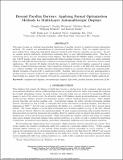Beyond parallax barriers: applying formal optimization methods to multilayer automultiscopic displays
Author(s)
Lanman, Douglas R.; Wetzstein, Gordon; Heidrich, Wolfgang; Raskar, Ramesh; Hirsch, Matthew Waggener
DownloadRaskar_Beyond parallax.pdf (13.48Mb)
PUBLISHER_POLICY
Publisher Policy
Article is made available in accordance with the publisher's policy and may be subject to US copyright law. Please refer to the publisher's site for terms of use.
Terms of use
Metadata
Show full item recordAbstract
This paper focuses on resolving long-standing limitations of parallax barriers by applying formal optimization methods. We consider two generalizations of conventional parallax barriers. First, we consider general two-layer architectures, supporting high-speed temporal variation with arbitrary opacities on each layer. Second, we consider general multi-layer architectures containing three or more light-attenuating layers. This line of research has led to two new attenuation-based displays. The High-Rank 3D (HR3D) display contains a stacked pair of LCD panels; rather than using heuristically-defined parallax barriers, both layers are jointly-optimized using low-rank light field factorization, resulting in increased brightness, refresh rate, and battery life for mobile applications. The Layered 3D display extends this approach to multi-layered displays composed of compact volumes of light-attenuating material. Such volumetric attenuators recreate a 4D light field when illuminated by a uniform backlight. We further introduce Polarization Fields as an optically-efficient and computationally efficient extension of Layered 3D to multi-layer LCDs. Together, these projects reveal new generalizations to parallax barrier concepts, enabled by the application of formal optimization methods to multi-layer attenuation-based designs in a manner that uniquely leverages the compressive nature of 3D scenes for display applications.
Date issued
2012-02Department
Massachusetts Institute of Technology. Media Laboratory; Program in Media Arts and Sciences (Massachusetts Institute of Technology)Journal
Proceedings of SPIE--the International Society for Optical Engineering; v. 8288
Publisher
SPIE
Citation
Lanman, Douglas, Gordon Wetzstein, Matthew Hirsch, Wolfgang Heidrich, and Ramesh Raskar. “Beyond parallax barriers: applying formal optimization methods to multilayer automultiscopic displays.” In Stereoscopic Displays and Applications XXIII, edited by Andrew J. Woods, Nicolas S. Holliman, and Gregg E. Favalora, 82880A-82880A-13. SPIE - International Society for Optical Engineering, 2012. © (2012) COPYRIGHT Society of Photo-Optical Instrumentation Engineers (SPIE)
Version: Final published version
ISBN
9780819489357
ISSN
0277-786X